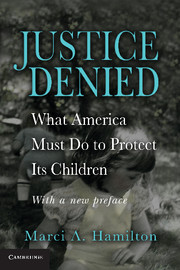Book contents
- Frontmatter
- Contents
- Acknowledgments
- 1 We Have Failed Our Children
- 2 What Is Wrong with the System? The Courthouse Doors Are Closed to Survivors
- 3 The Solution Is Clear and Simple: Abolish the Statutes of Limitation for Childhood Sexual Abuse
- 4 What It Will Take to Protect Children: What the States Must Do; What the Federal Government Should Do
- 5 Barrier #1: The Insurance Industry
- 6 Barrier #2: The Hierarchy of the Roman Catholic Church
- 7 The Other Barriers: Teachers, Defense Attorneys, and an Uninformed Public
- Conclusion: The Coming Civil Rights Movement for Children
- Appendix to Chapter 4
- Appendixes to Chapter 6
- Notes
- Index
3 - The Solution Is Clear and Simple: Abolish the Statutes of Limitation for Childhood Sexual Abuse
Published online by Cambridge University Press: 03 May 2010
- Frontmatter
- Contents
- Acknowledgments
- 1 We Have Failed Our Children
- 2 What Is Wrong with the System? The Courthouse Doors Are Closed to Survivors
- 3 The Solution Is Clear and Simple: Abolish the Statutes of Limitation for Childhood Sexual Abuse
- 4 What It Will Take to Protect Children: What the States Must Do; What the Federal Government Should Do
- 5 Barrier #1: The Insurance Industry
- 6 Barrier #2: The Hierarchy of the Roman Catholic Church
- 7 The Other Barriers: Teachers, Defense Attorneys, and an Uninformed Public
- Conclusion: The Coming Civil Rights Movement for Children
- Appendix to Chapter 4
- Appendixes to Chapter 6
- Notes
- Index
Summary
Plenty of issues need legislative repair, but many need extensive study before the law is changed. Reform to aid child sex abuse victims does not require this sort of deliberation and delay. The problem is clear and the remedy is simple: get rid of the statutes of limitations (SOLs).
In this chapter, I will explain why this is the obvious and best reform available. Despite the simple logic behind eliminating the SOLs, there has been vigorous, if not desperate, opposition to this sort of reform. In the second half of the book, I will identify who – the insurance industry, the Catholic Church hierarchy, defense attorneys, and teachers – has tried to block legislative change so obviously beneficial for children and our society and why they are opposed. The enemies of reform have fought hard and dirty, but they are losing ground.
The Vicious Cycle: Survivors Can't Tell, Claims Expire, and Perpetrators Confidently Move On
The law generates a vicious cycle that keeps predators free as it creates more victims. First, survivors of childhood sexual abuse typically take decades to come forward, so even seemingly generous SOLs can be ineffective. Once a survivor's claim is foreclosed, the perpetrator can put another notch on his belt for yet another victim who will be unable to stop his preying behavior.
Second, because of the way we have constructed the system, child sex abuse survivors do not receive adequate encouragement, protection, and nurturing to come forward publicly at all.
- Type
- Chapter
- Information
- Justice DeniedWhat America Must Do to Protect its Children, pp. 21 - 36Publisher: Cambridge University PressPrint publication year: 2008

